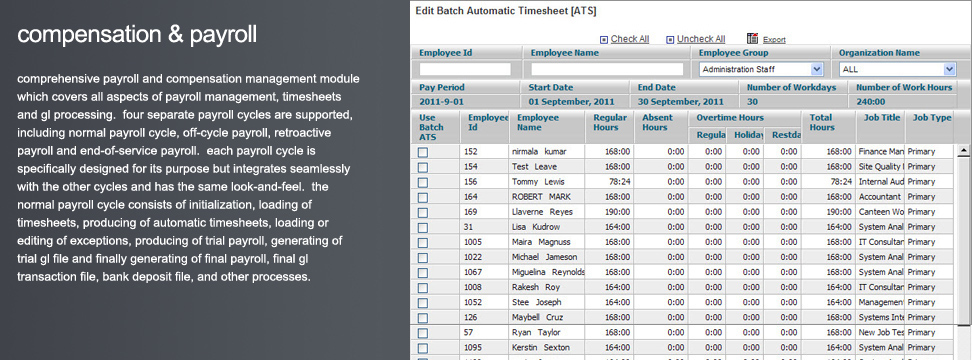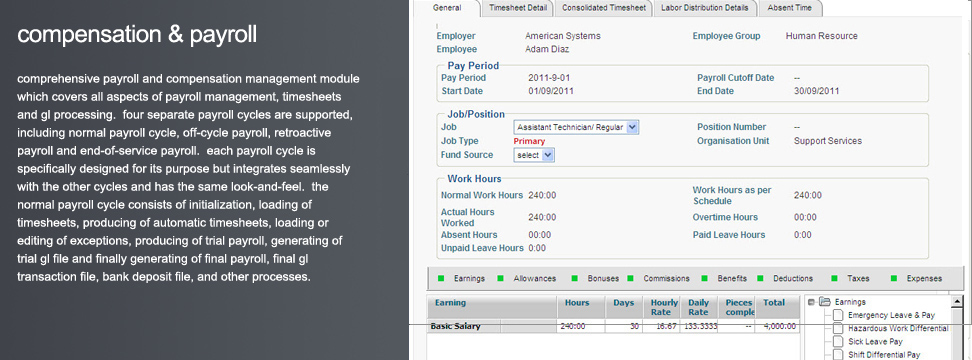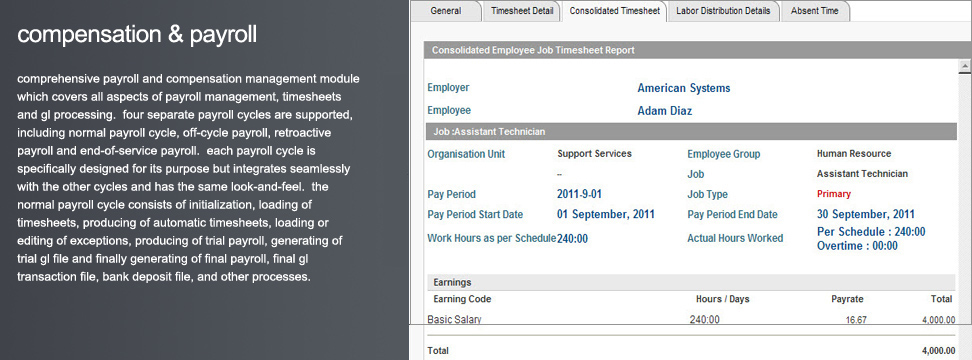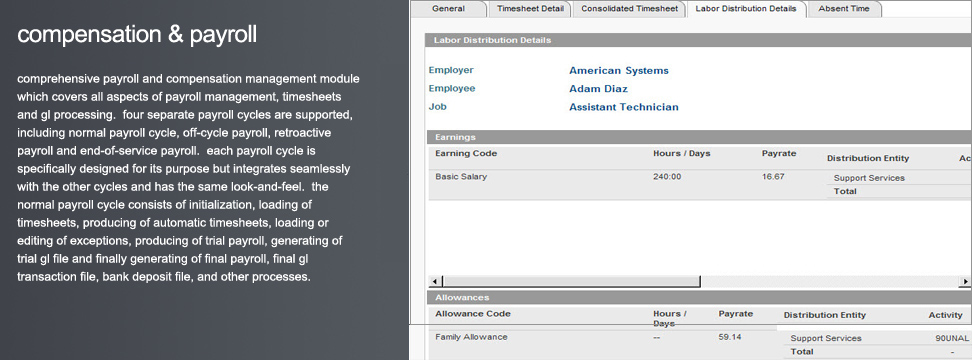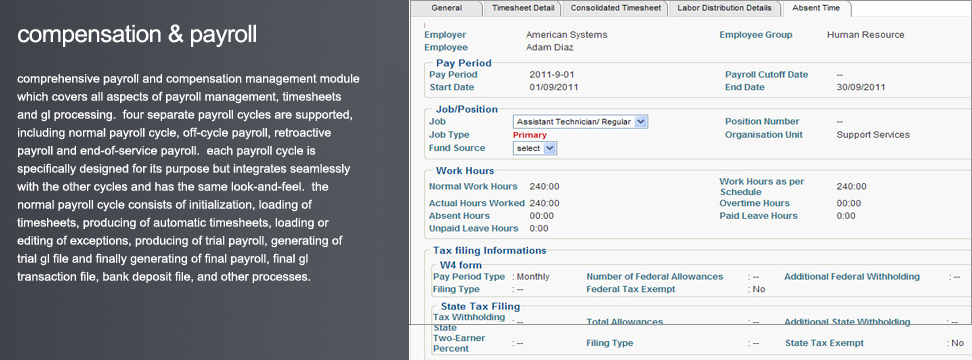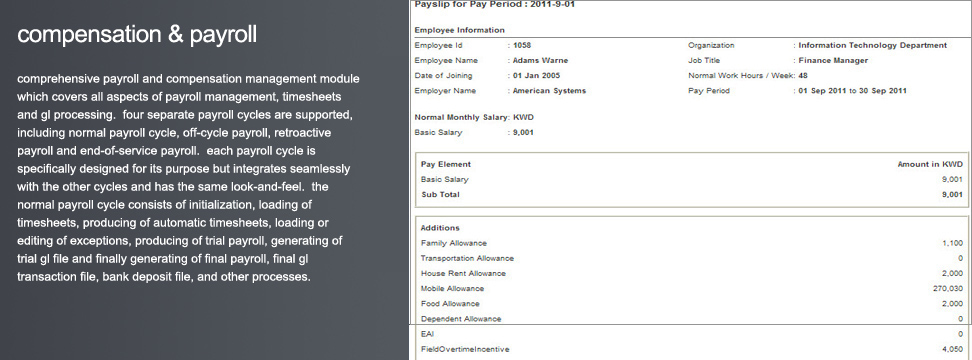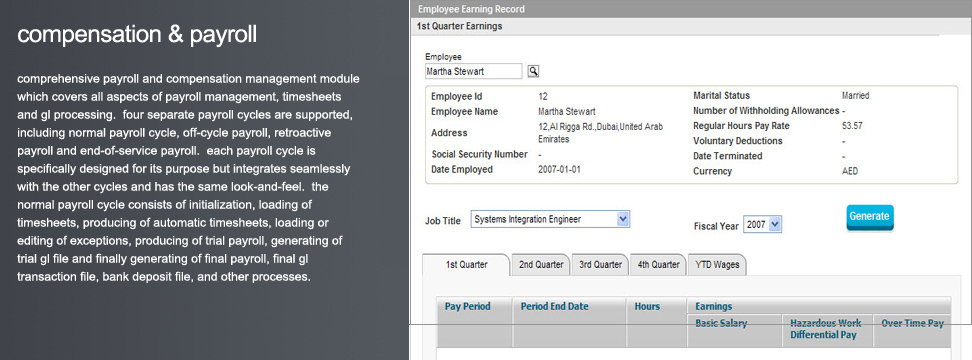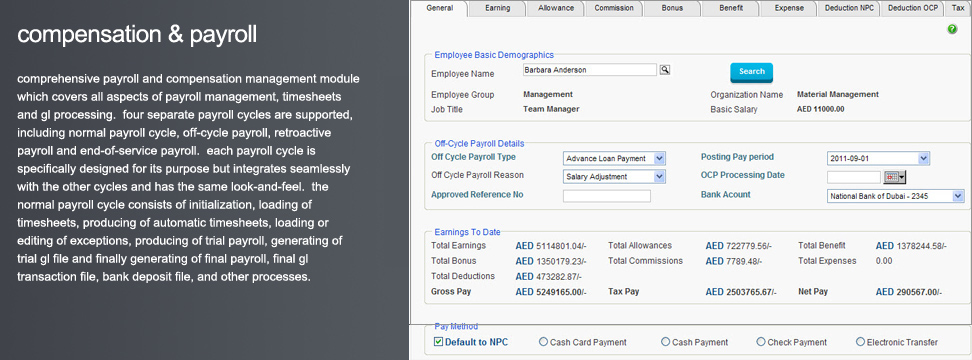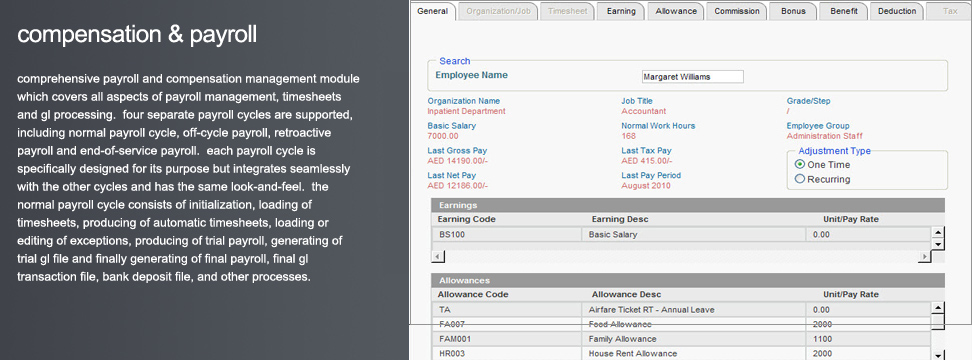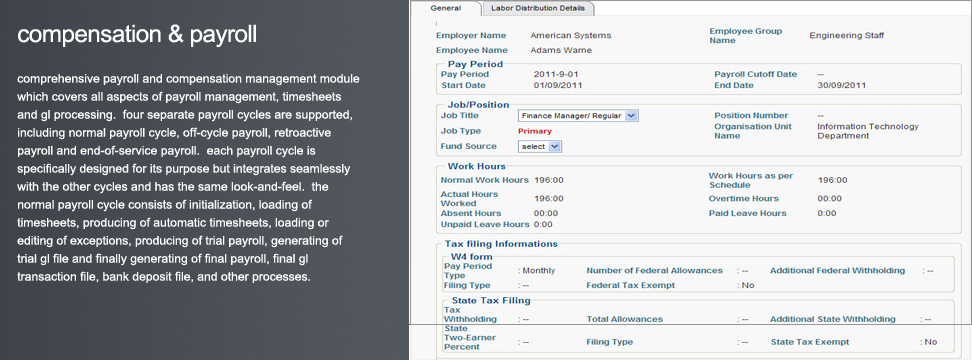 Compensation & Payroll |
Interact HRMS offers a comprehensive global payroll and compensation management which is totally integrated with the employee contract management module and with the time and leave tracking module. It supports both timesheet and deliverable based earnings as well as unlimited Earnings, Benefits, Allowances, Commissions, Bonuses, Deductions, and Taxes. It supports payroll best practices including Auto Time Sheet generation, default time sheet, unlimited trial payroll runs, and final payroll run with a comprehensive audit trail. Interact Payroll supports paycheck printing as well as electronic payroll bank deposits, cash cards, and cash payments. More than 250 payroll reports and payroll related audit reports are included with multicurrency support.
In the Payroll Parameter Setup, the User can define the key parameters which will drive the payroll process. This relates to the standard Payroll Calendar, Standard Minimum and Maximum Work Days / Hours per Pay Period, Work Hours per Day, the Rounding Method, Rules about deducting Absent Hours and much more. It also allows the user to define the default Pay Period either for the whole company or for a particular Employee Group in the company. Pay Periods include Weekly, Semi-Montly, Biweekly, Monthly and Quarterly. Alternatively, entirely unique Pay Periods can also be defined.
The Payroll Process can be fully flexible for the user to choose the steps and their order or can be highly structured and defined whereby a default Payroll Officer can be defined for each step in the Payroll process and the system can alert the appropriate user of the next required step in the payroll process. The most basic Payroll Process in Interact HRMS consists of 6 steps:
- Payroll initialization
- Automatic Time Sheet
- Trial Payroll
- Final Payroll
- GL Processing
- GL Posting
Additional steps can be added, specific Workflow processes can be associated with each step, incase there are separate reviews or approvals needed and alerts can be triggered if specific steps are not completed within the defined timeframe or if specific conditions occur which require an alert by email, SMS, or through the Interact MyPage.
Each Payroll Policy type (Earning, Allowance, Deduction, Commission, Bonus, Expense, Tax), will have its own unique definition forms, allowing for unique behavior in the payroll. This includes some of the following;
Earnings:
- Can be used for Salaried, Hourly or Piecework employees
- Earning can be paid in any Currency
- Associate Earning with Org Units, Employee Groups or Grade and Steps so new Employees will inherit the Earning Policy depending on which Org Unit, Employee Group or Grade/Step they have been hired in
- Can be taxable at Federal, State or City level
- Can be setup as deferred Earning to be paid later
- Define an Earning as a Retroactive Adjustment
- Define an Earning as a Previous Payperiod Adjustment
- Includes Effecitve Date and Stop Date
- Calculation Method can be
- Time Dependent (with different options as Earning Time Unit of Measure – Day, Hour, Month, Year)
- Flat Amount (with an Earning Pay Rate per Unit and a Pay Factor)
- Rate Table (Rate Table can be dependent on Deliverables, Dependents, Education, Grade Step, Grade Step Education, Salary Scale, Seniority or a User Defined set of Variables)
- Based on Piece Work Units
- Function of
- Basic Salary
- Net Salary after Tax Deducdtion
- Gross Salary
- Expression using the Expression Builder which supports
- Tables (All Tables and All Fields available in Interact HRMS)
- Functions (Mathematical, String, Date & Time)
- DBFunctions (Aggregate, String Comparison, Mathematical, Date & Time, Full Text Search, Information, Miscelanneous)
- Operators (Arithmetic, Assignment, Bitwise, Comparison, Error Control, Execution, Incrementing/Decrementing, Logical, String, Array)
- DBOperators (Arithmetic, Comparison, Bitwise, Logical)
- Expressions
- Control Structures (Statements, Repeat Structures)
- PHP Script (for complex expressions)
- Support many different types of Overtime and Shift Differential Calculations, including Day OT Rate, Evening OT Rate, Night OT Rate, Rest Day/Weekend OT Rate
- Ability to Define Maximum OT Hours
- Ability to Transfer OT Hours
- Define Different OT Rates by Holiday
- Flag if Earning should be excluded if Employee is on a particular type of Paid or Unpaid Leave
- Setup Time/Labor Allocation to be either Fixed or Percentage based or Both
- Define Fund Source of the Earning
- Define Budget Item linked with the Earning
- Define Expense Cost Item linked with the Earning
- Define Liability Cost Item linked with the Earning
- Distribute Labor Cost by Cost Center, Project or Contract
Allowances
- Supports Different Allowance Types (Expense, Monetary, Non-Monetary, etc)
- Allowance can be a Retroactive Adjustment
- Allowance can be paid in any Currency
- Allowance can be Taxable at Federal, State or City Level
- Leave Code can be Associated with an Allowance
- Allowance can be Deferred and Date for When to Pay the Deferred Allowance can be defined at the Employee Level
- Allowance Policy can be Effective Dated with Effective and Stop Date
- Allowance can have an Effective Status set to Active or Inactive
- Allowance can be set to be Processed Every Pay Period or Every Alternative Pay Period
- Allowance can be Time Dependent (based on Actual Work Hours)
- Allowance can be a Function of
- Basic Salary
- Net Salary after Tax Deduction
- Expression framed in the Expression Builder (similar to Earning Definition above)
- Allowance Calculation can be based on a User Defined Rate Table
- Allowance Calculation can be based on a standard Allowance Rate Table using Parameters such as:
- Basic Salary Range (From / To)
- Nationality
- Seniority Range (From / To)
- Marital Status
- Minimum Number of Children
- Maximum Number of Children
- Number of Children
- Payment Type (Flat, No. of Pay Days or Percentage)
- Value (Per Child or For All Children)
- Allowance can be linked with Fund Source, Cost Item, Budget Item, Liability Item, Expense Item, Payable, Bank/Asset)
- Non Monetary Allowance can be Defined, including the following:
- Airfare Ticket
- Company Cell Phone
- Company Cafeteria
- Company Parking
- Company Recreation Center
- Company Car
- Company Health Care Plan
- Company Uniform
- Company School
- Company Transportation
- Company Housing
- Company Gym
- Company Babysitter
- Other
- Accrual Provision Annual Cost can be Set at the Employee Level for Each Allowance
- Labor Cost Distribution for Allowances can be done by Project, Contract or Cost Center
Deductions
- Deductions can be Paid in any Currency
- Deductions can be defined for Retroactive Adjustment
- Deductions can be defined for Previous Payperiod Adjustments
- Deductions can be defined for Timesheet Adjustments
- Deductions can be setup to be Deferred
- Deduction Policies can be Effective Dated with a Start and Stop Date
- Deductions can be set to Active or Inactive
- Calculation Method for Deductions includes
- Time Dependent with Deduction Time Unit of Measure (Day, Hour, Month, Year)
- Using Deduction Rate Table
- Deduction can be set as Function of
- Basic Salary
- Gross Salary Before Tax Deduction
- Gross Salary After Tax (User can Determine which Allowances to Include in Gross Salary Calculation)
- Expression using Expression Builder (same as Earning Defintion Expression Builder Defined Above)
- Expression can be a Script
- Deductions can be Taxable at Federal, State and City Level
- Deductions can be Set as Previous Pay Period Excess Deduction Adjustment
- Deductions can be Set as Flex Leave Purchase Deduction
- Override of Deduction can be Allowed as the Result of an HR Action (Amendment, Promotion, etc)
- Deduction can be made for Third Party
- Deductions can be Controlled for Minimum Take Home Pay
- Deductions can be set up with their own Deduction Priority
- Deductions can be linked with Fund Source, Cost Item, Budget Item, Liability Item, Expense, Payable, Bank/Asset
- Distribute Labor Cost by Cost Center, Project or Contract
Commissions
- Commissions can be Paid in any Currency
- Commissions can be set as Retroactive Adjustments
- Commissions can be Taxable at the Federal, State and City Level
- Commissions can be set as Deferred Commissions
- Commissions can be Effective Dated with a Start and Stop Date
- Commissions Calculation Method can be
- Flat Amount with a Rate per Unit
- Based on Commission Rate Table
- Based on Commission Expression using Expression Builder (as described above under Earnings, Allowances, Deductions, etc.)
- Labor Cost Distribution can be done by Cost Center, Project or Contract
- Commission can be linked with a Specific Fund Source, Budget Item, Expense Cost Item, Liability Cost Item
- Commissions can be Linked with Specific Product Types
- Commissions can be Linked with the Commission Management module which allows for Sophisticated Setup and Calculation of Commission Schemes
Bonuses
- Bonuses can be paid in any Currency
- Bonuses can be Effective Date with a Start and End Date
- Bonuses can be Retroactive Adjustment
- Bonuses can be Function of
- Previous Gross Pay
- Previous Net Pay Before Tax
- Previous Net Pay After Tax
- Bonuses can be Taxable at Federal, State and City Level
- Bonuses can be Deferred
- Bonuses can be Time Dependent with any Time Unit of Measure and Pay Rate per Unit
- Bonuses can be a Flat Amount with any Pay Factor
- Bonuses can be based on a Standard Rate Table with multiple Variables including
- Deliverable Rate Table
- Dependents
- Education
- Grade Step
- Grade Step & Education
- Salary Scale
- Seniority
- User Defined Rate Table
- Bonuses can be Performance Dependent with a Specific Performance Goal Type
- Bonuses can be One Time or Recurring
- Bonuses can be Goal Based with the Option to Define Performance Goal to Reach to Qualify for the Bonus
- Bonuses can be based on Averages with an Average Factor
- Bonuses can be setup with Labor Distribution by Project, Contract or Cost Center
- Bonuses can be linked with Fund Source, Cost Item, Budget Item, Liability Item
Benefits
- Benefits can be paid in any Currency
- Benefits can be Retroactive Adjustments
- Benefits can be Previous Pay Period Adjustments
- Benefits can be Effective Date with a Start and Stop Date
- Benefits can be Included or Excluded from GL/JV Posting
- Benefits can be Processed Every Pay Period or Every Alternative Pay Period
- Benefits can be Time Dependent with a Benefit Time Unit of Measure
- Benefits can be a Flat Amount
- Benefits can be an Expression defined using the Expression Builder as described above
- Benefits can be setup with Benefit Rate Table Values
- Benefits can be setup with Health Care Plan Rate Table
- Health Care Plan Rates can be Increased or Decreased with Percentage or Flat Amount
- Benefits can be setup with Separate Employee Contribution Percentage and Employer Contribution Percentage
- Benefits can be linked to Third Party Benefit Providers
- Benefits can be setup with Labor Distribution by Cost Center, Project or Contract
- Benefits can be defined with Separate Fund Source for Employee and Fund Source for Employer, Budget Item, Expense Cost Item and Liability Cost Item
- Benefits can be Linked with different Benefit Providers
Expenses
- Expenses can be paid in any Currency
- Expenses can be Linked to Allowances
- Expenses can be Loaded through Batch Expense Sheets and Personal Expense Sheet through Employee Self Service
- Expenses can be Distributed by Cost Center, Project or Contract
- Expenses can be Billable or Non Billable
Taxes
- Interact’s Tax Engine is designed as a Global Tax Engine which can be Used to Define Any Tax in Any Country without any Customization
- Tax Calculation Types
- Step Based
- Bracket Based
- Cumulative
- Taxes can be Deferred
- Taxes support EIC with a Setting for Maximum Earning Per Pay Period to Qualify for EIC
- Tax Calculation Method can be
- Percentage Based
- Wage Bracket Based
- Unlimited Number of Tax Authorities can be Defined with Address, Contact Person and Phone
- Calculation Method supports
- Time Dependent
- Flat Amount
- Function of Basic Salary
- Function of Gross Salary
- After Exemption
- Calculate Tax After Deducting Personal Tax Exemption
- Tax Expression as a Script
- Local Tax
- Applying Standard Deduction with Min & Max Percentage
- Separate Bonus Based Tax Exemptions with a Bonus Exemption Ceiling
- Tax Expression which supports
- Tables (All Tables and All Fields available in Interact HRMS)
- Functions (Mathematical, String, Date & Time)
- DBFunctions (Aggregate, String Comparison, Mathematical, Date & Time, Full Text Search, Information, Miscelanneous)
- Operators (Arithmetic, Assignment, Bitwise, Comparison, Error Control, Execution, Incrementing/Decrementing, Logical, String, Array)
- DBOperators (Arithmetic, Comparison, Bitwise, Logical)
- Expressions
- Control Structures (Statements, Repeat Structures)
- Labor Costing by Cost Center, Project or Contract
General Features:
- Payroll Calendar Definition by Employer.
- Normal Payroll Cycle with user definable pay-periods
- Off-Cycle Payroll
- Retroactive Payroll management
- End-of-Service Payroll management
- Default Earning, Allowances, Benefits, Commissions, Deductions, and Tax Withholding definition by Employee Group and Organization Unit.
- Automatic Inheritance of Earning, Allowances, Benefits, Commissions, Deductions, and Tax Withholding from employee group when creating employment contract.
- Auto Timesheet (ATS) Generation from Attendance Timesheet.
- Auto-Posting of Leave Taken as Earning in ATS
- Predefined calculation method of earnings, allowances, benefits, deductions, and tax withholdings.
- Multiple payroll Trial-Runs without affecting the database
- Multicurrency Support.
- Final Payroll Run and Closing of Pay Period.
- Support both check printing as well Bank Direct Deposit.
- Electronic Bank Deposit Advise through Employee Self-Service.
- Electronic Check Slip through Employee Self-Service.
- Automatic posting of leave earning to Payroll Timesheet.
- Automatic Leave Accrual at the end of each pay period.
- Payroll Ledger Posting to the GL
- Supports Multiple Bank Accounts


